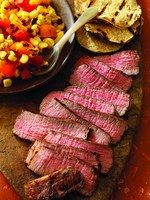Prairie Fare: Experience the Umami Taste Sensation in Your Menus
(Click an image below to view a high-resolution image that can be downloaded)
By Julie Garden-Robinson, Food and Nutrition Specialist
NDSU Extension Service
“You must not like the umami taste,” I commented to my 8-year-old daughter when she wrinkled her nose at the casserole.
“’Oo-whaty’?” she asked, not recognizing the word.
“It’s pronounced ‘Oo-mommy.’ I learned more about it at a conference,” I said.
“We have taste buds that detect sweet, sour, salty and bitter. Umami was named the fifth taste, and some people call the taste savory or meaty,” I noted.
“I’ve heard of umami. I read about it in one of my magazines. Umami means delicious in Japanese,” my 13-year-old daughter commented.
“That’s right. To experience umami, we tried regular meatballs and meatballs with added tomato juice and mushrooms at my conference,” I continued.
I doubt my younger daughter was impressed with this new knowledge. I don’t think she wanted me to try the recipe at home, either.
“Well, I don’t like all the onions you put in food,” she remarked as she picked the onions out of the casserole and ate the meat and cheese.
She was experiencing umami without knowing it.
We used to think that our tongues could be “mapped” with particular taste buds in certain areas. Now we know that taste buds are throughout the oral cavity.
When we experience a flavor we truly enjoy, it involves not only taste, but also several other factors. The aroma, appearance, texture and our previous experiences all play a role in our flavor experiences.
Foods that provide the umami taste are rich in glutamate, a form of an amino acid or protein building block. Umami also is linked to foods that naturally contain inosinate and guanylate, which are nucleotides (building blocks of genetic material).
Meats, such as beef, pork and chicken, are naturally high in the compounds with the umami factor. Other foods with the umami taste are mushrooms (especially dried shitakes) and vegetables such as tomatoes and tomato juice, carrots, sweet potatoes and Chinese cabbage. Aged cheese (such as parmesan and Roquefort), cured meats, shellfish, fish and fish sauce also contribute the umami taste.
If you have noticed that ketchup enhances the flavor of your cheeseburger, you are experiencing the umami taste. Try adding some tomato sauce to your meatloaf when you are mixing it or sprinkle your spaghetti sauce with Parmesan cheese to enjoy the umami taste.
Combining foods that are rich in the umami taste can amplify the flavor in your menus. You also can make your recipes more healthful. For example, you can boost the flavor of low-sodium foods by incorporating umami ingredients.
If you want to tantalize your tongue, try this recipe from the Cattlemen’s Beef Board at http://www.beefitswhatsfordinner.com.
Grilled Southwest Steaks With Sunset Salad
2 beef eye round steaks, cut 1 inch thick (8 ounces each)
Marinade:
1/3 c. fresh lime juice
2 tsp. ground cumin
2 tsp. steak seasoning blend
2 tsp. finely chopped chipotle peppers in adobo sauce
Sunset Salad:
2 small ears of corn, husked
2 large yellow, orange and/or red bell peppers, cut lengthwise in half
1 medium tomato, chopped
1 Tbsp. olive oil
Combine marinade ingredients in small bowl. Reserve and refrigerate 2 Tbsp. of marinade in a covered bowl for the sunset salad. Place steaks and remaining marinade in food-safe plastic bag; turn steaks to coat. Close bag securely and marinate in refrigerator for six hours or as long as overnight, turning occasionally.
Place corn and bell peppers on grid over medium, ash-covered coals; grill peppers, uncovered, 15 to 20 minutes (over medium heat on preheated gas grill, covered, 15 to 20 minutes) and corn 20 to 25 minutes (over medium heat on preheated gas grill, covered) or until tender, turning occasionally. Remove; set aside to cool slightly.
Add three to four additional briquettes to each side of fire grate to maintain medium heat, if necessary. Remove steaks from marinade; discard marinade. Place steaks on grid over medium, ash-covered coals. Grill, uncovered, for 19 to 23 minutes (over medium heat on preheated gas grill, covered, for 17 to 19 minutes) for medium rare (145 F) doneness, turning occasionally.
Meanwhile, to prepare Sunset Salad, chop bell peppers and cut corn kernels from cobs; place in medium bowl. Add tomato. Whisk reserved marinade and oil in small bowl until blended. Pour over vegetables; toss to coat.
Carve steaks into thin slices. Serve with salad.
Cook's tip: 1 c. frozen corn, thawed, may be substituted for fresh corn. Heat medium skillet over medium-high heat for two minutes or until hot; add corn. Cook two to four minutes or until corn starts to brown, stirring frequently.
Makes four servings. Each serving has 258 calories, 9 grams (g) of fat, 28 g of protein, 19 g of carbohydrate, 284 milligrams of sodium, 19 g of carbohydrate and 3.7 g of fiber.
(Julie Garden-Robinson, Ph.D., R.D., L.R.D., is a North Dakota State University Extension Service food and nutrition specialist and associate professor in the Department of Health, Nutrition and Exercise Sciences.)
NDSU Agriculture Communication – Aug. 4, 2011
| Source: | Julie Garden-Robinson, (701) 231-7187, julie.garden-robinson@ndsu.edu |
|---|---|
| Editor: | Rich Mattern, (701) 231-6136, richard.mattern@ndsu.edu |



